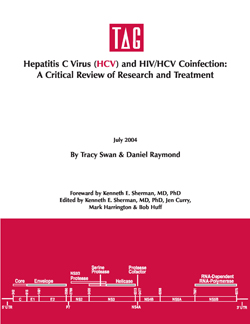July 2004
By Tracy Swan & Daniel Raymond
INTRODUCTION
TAG’s Hepatitis C and HIV/HCV Coinfection Report is a comprehensive review of basic and clinical science accompanied by recommendations for research and policy. It was written for people living with hepatitis C or HIV/HCV coinfection, clinicians, researchers, activists, educators, and advocates.
The Hepatitis C and HIV/HCV Coinfection Report reflects my experience. I have worked for more than ten years as a direct service provider to people at risk for, or living with, HCV and HIV, which has contributed to my understanding of their needs. While I was writing this report, I reviewed more than a thousand journal articles and hundreds of conference abstracts, and interviewed researchers, clinicians, coinfected individuals, and advocates.
TAG’s original hepatitis report was released in July of 2000. Since then, HCV-related end-stage liver disease has been recognized as a leading cause of death among people with HIV. For people with HCV monoinfection, liver-related deaths are projected to increase by 180% over the next 20 years. Meanwhile, a more effective therapy, pegylated interferon, has been approved for treatment of HCV, and researchers are moving closer towards an understanding of HCV pathogenesis. The Hepatitis C and HIV/HCV Coinfection Report is a synthesis of current knowledge; key issues are highlighted in the Recommendations section at the end of each chapter.
Despite advances in treatment, many barriers to optimal care and treatment of people with HCV and HIV/HCV remain. As with HIV, HCV is a lens that magnifies the intersection of medical and social inequities. In the U.S., both viruses disproportionately affect African Americans and other groups who have traditionally had poor access to care and treatment, including the incarcerated, the poor, people with psychiatric disorders, and injection drug users. Up to 90% of injection drug users are infected with HCV. Injection drug users in particular are regarded with an astounding degree of contempt by most of society. Draconian drug laws and inadequate access to sterile syringes have created penalties for drug use that exceed incarceration alone by costing people their health and, ultimately, their lives. Until we acknowledge that HCV is a disease that is prevalent among injection drug users and demand expansion of needle exchange programs, universal availability of syringes through legalized pharmacy sale, access to methadone maintenance therapy, and drug treatment upon request, we will not be able to mitigate the spread of hepatitis C.
Access to care and treatment is not just an issue for injection drug users. In the United States, access to health care for the poor is restricted; more than 43 million Americans are uninsured. Cuts in federal funding for programs such as AIDS Drug Assistance Programs and Medicaid threaten access to health care for the more than 42 million Americans who rely on them. Drug prices are exorbitant; the 48-week course of treatment for HCV costs as much as $40,000.
Even individuals with access to health care suffer from the constraints of managed care and a lack of provider and patient education about HCV; these factors collectively make it difficult to insure that people with HCV receive optimal care. Many clinicians work in health care settings ill-suited to providing care for dually or multiply diagnosed individuals. Successful models of service delivery to injection drug users and people with psychiatric co-morbidities must be imported into the clinic. Clinicians must take a proactive approach to managing drug-related adverse events by educating people about them before initiating treatment, providing options to ameliorate them and offering access, where indicated, to mental health care. While pressuring the medical system to meet these needs, people must receive clear and direct education about transmission, prevention, diagnostics, care, and treatment of HCV and HIV/HCV.
Preparation and implementation require resources. Very little funding is specifically designated for HCV prevention and education services, nor are there any validated and established models for such programs. HCV prevention and education must be integrated into programming at AIDS service organizations and available to staff and participants at methadone clinics, syringe exchanges, detoxification facilities, residential drug and alcohol treatment programs, homeless shelters, and correctional facilities. Information and services must reach those who need them most, not merely those who are the easiest to reach.
Progress toward new treatments and improvements in efficacy of existing HCV therapy has been hampered by the absence of a coordinated research agenda for hepatitis C. HCV research is currently spread across different NIH institutes without the oversight that exists for HIV research from the NIH Office of AIDS Research (OAR). Currently, there is no mechanism for meaningful community participation in the development of a research agenda for HCV.
The current situation demands intensified, focused action: members of the HCV and HIV communities need to work together to advocate for prevention initiatives, broadened access to care and treatment for HCV and HIV/HCV, and a comprehensive research agenda.

